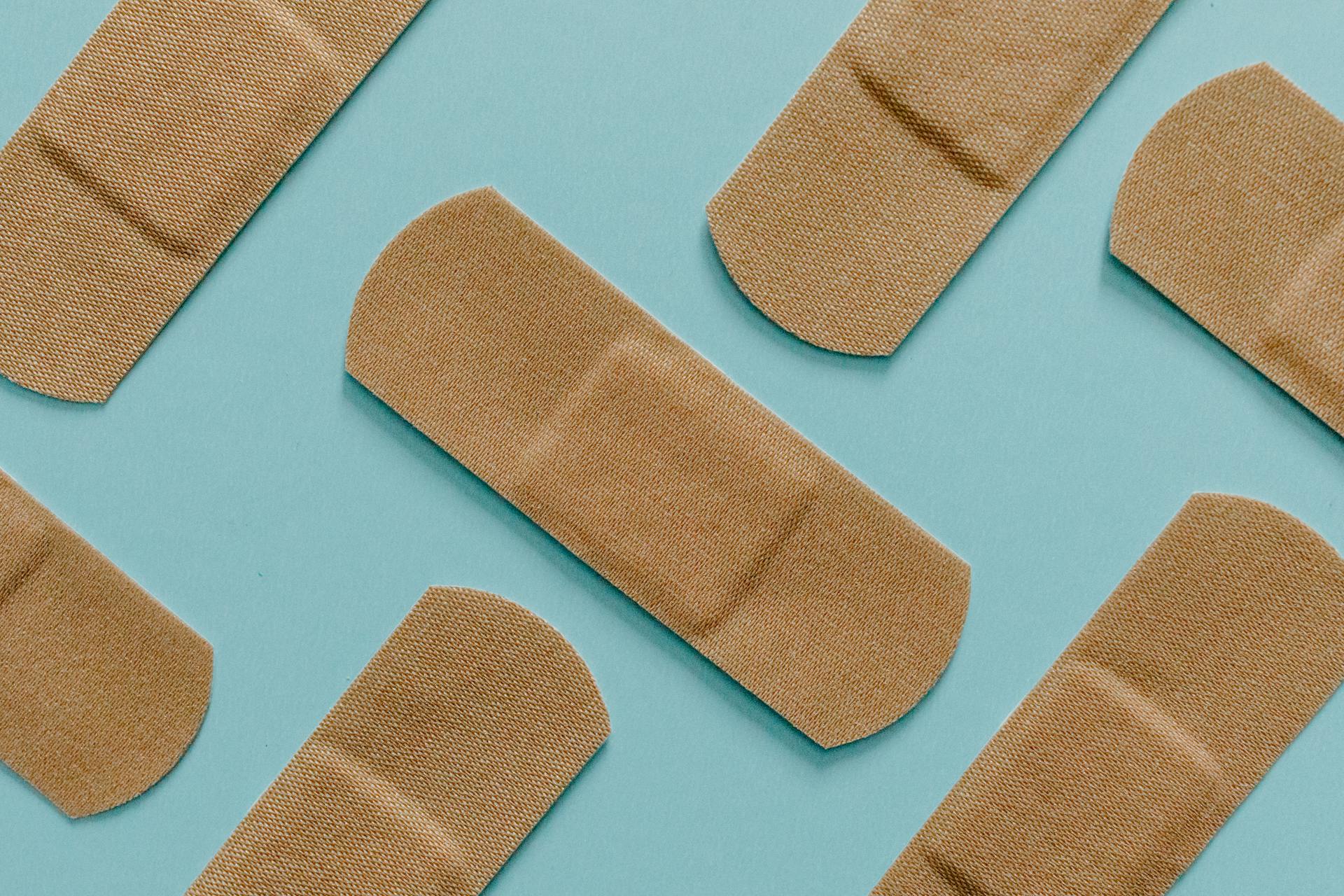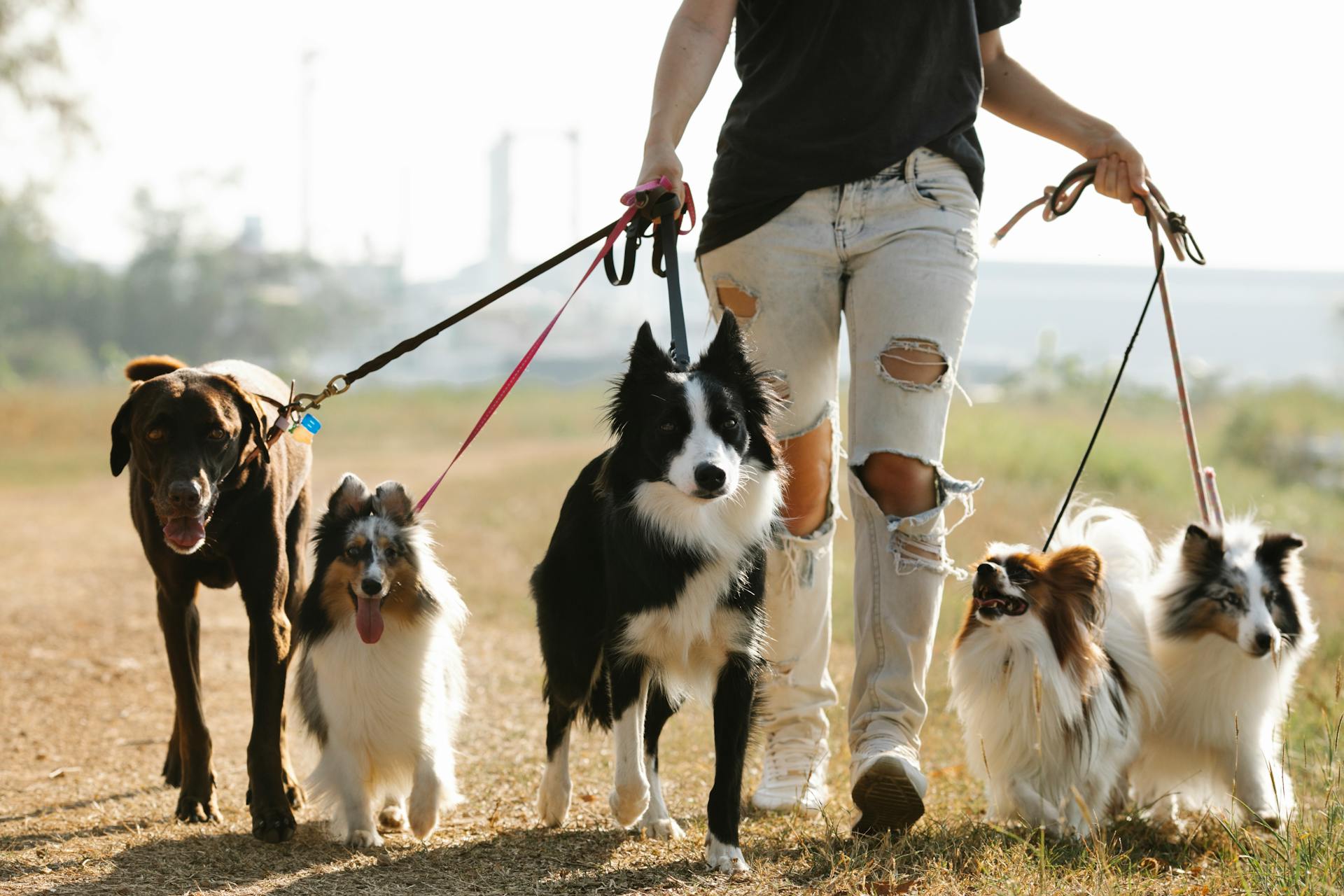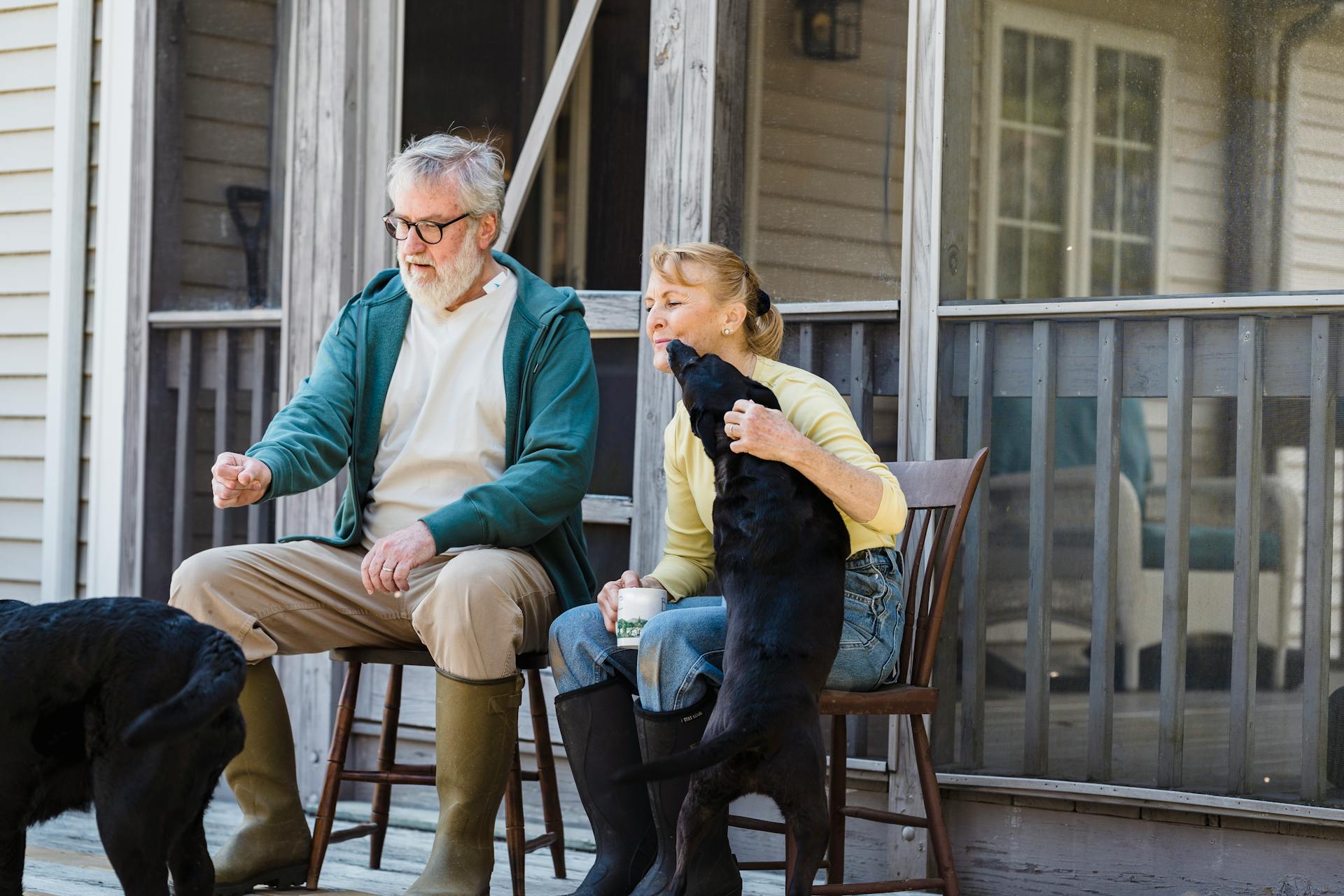
If your furry friend has suffered a wound, it's essential to know the right first aid and home care techniques to promote healing and prevent infection.
Cuts are one of the most common types of dog wounds, often caused by sharp objects like glass or metal. A cut can be shallow or deep, and it's crucial to clean and dress it promptly to prevent infection.
Debridement is a crucial step in treating cuts, which involves removing dead tissue and debris from the wound to promote healing. This can be done at home with saline solution and gauze.
Lacerations are another type of dog wound, often caused by blunt trauma like a fall or a car accident. They can be jagged and may require stitches to close the wound properly.
First Aid for Dog Wounds
Having a pet first aid kit on hand is crucial in case your dog gets hurt. A muzzle, soap or cleaning solution, pet antiseptic solution, antimicrobial ointment, and sterile bandages are must-haves.
To clean a wound, gently rinse it with clean water, and if needed, add a small amount of mild baby shampoo, dish soap, or hand soap. Avoid using harsh cleaners or caustic products like hydrogen peroxide or rubbing alcohol.
To control bleeding, apply pressure using a clean towel for at least 10 minutes. If the bleeding doesn't stop after 10 minutes, seek veterinary attention right away.
Clean the Wound
If your dog has a wound, the first step is to clean it. You'll want to rinse the wound with clean water to remove any dirt or debris.
Rinsing the wound is especially important if it's on your dog's paw. You can swish the injured paw around in a clean bowl or bucket of warm water to help clean it out. For wounds elsewhere on the body, you can place your dog in a sink, bath, or shower and gently run clean water over the wound.
Explore further: Dogs in Water
You may want to add a small amount of mild soap to the water to help clean the wound. Some good options include mild baby shampoo, dish soap, or hand soap. Just be sure to avoid using harsh cleaners or other caustic products that can hurt your dog's skin.
Here are some soap options you can use to clean your dog's wound:
- Mild baby shampoo
- Dish soap
- Hand soap
Remember, never use hydrogen peroxide, rubbing alcohol, or other caustic cleaning products on your dog's skin, as these can be painful and slow down the healing process.
Control Bleeding
If your dog is injured and bleeding, the first thing to do is apply pressure to the wound using a clean towel. Most small wounds will stop bleeding within a couple of minutes.
Bleeding from larger wounds can take longer, but it should stop within 10 minutes of applying pressure.
Recommended read: Stop Dog
Types of Dog Wounds
Dog wounds can be categorized into two main types: open and closed. Open wounds occur when there is a break in the skin, exposing internal tissues, and often bleed.
Open wounds can be caused by cuts, while closed wounds don't expose internal tissues, but may still have internal bleeding, such as in the case of bruises and fractures that don't break the skin.
Some common types of wounds include lacerations, puncture wounds, and bite wounds. Lacerations are jagged cuts or tears to the skin, often caused by stepping on glass or running into an object with a sharp edge. Puncture wounds are caused by the pointy edge of an object piercing the skin, and can be particularly serious because they can penetrate deep into tissue layers and lead to bacterial infections.
Here are some common characteristics of wounds:
- Open wounds: break in the skin, exposing internal tissues, often bleed.
- Closed wounds: don't expose internal tissues, but may have internal bleeding.
- Lacerations: jagged cuts or tears, often caused by sharp edges.
- Puncture wounds: caused by pointy objects piercing the skin, can be deep and lead to infections.
- Bite wounds: caused by dog bites or wild animal bites, can be serious due to depth, bacterial infections, and disease transmission.
Check for Foreign Objects
When checking for foreign objects in a wound, it's essential to be gentle and careful. If you can easily remove the object with tweezers, do so.
If the object is lodged deeply, don't try to remove it yourself. Instead, leave it and call your veterinarian or an emergency vet immediately.
This is especially important if the wound is on your dog's paw pad and they may have stepped on something sharp. You may not be able to see the object, but it can cause serious problems if not removed properly.
Puncture wounds can be caused by various things, including gunshot wounds, bites from other animals, or foreign-body penetration. Foreign material trapped in the wound can lead to delayed or lack of healing, localized infection, and/or tetanus.
It's crucial to note that wounds on the body (thorax or abdomen) can be more severe than they initially appear and always need to be addressed by a veterinarian.
Here are some general guidelines for checking for foreign objects:
- Look for objects or debris that may be lodged in the wound.
- Use tweezers to remove objects if they are easily accessible.
- Leave the object alone if it's lodged deeply and seek veterinary help.
Bite
Bite wounds are a serious concern for dog owners. They can be caused by fighting with other dogs, but also by cats or wildlife. Puncture wounds from teeth tend to damage tissues below the skin's surface and are prone to infection.
Immediate care with a veterinarian is needed if your dog scuffles with another dog, cat, or wild animal. This is true for several reasons: animal teeth drive bacteria deep into wounds, your dog might need a rabies booster, and bite wounds can have underlying trauma to muscles and other tissues.
Bite wounds can penetrate deep into the tissue layers, leading to bacterial infections. Dog bites can contain bacteria like those that cause tetanus, and wild animal bites may spread diseases like rabies.
If you notice your dog has a bite wound, stop the bleeding and contact your veterinarian right away. It's not uncommon for a stick or other sharp object to penetrate a wound and become lodged within it, leading to delayed or lack of healing, localized infection, and/or tetanus.
Here are some key factors to consider when dealing with bite wounds:
- Depth: Bite wounds can penetrate deep into the tissue layers.
- Bacterial Infections: Dog bites can contain bacteria like tetanus.
- Disease: Wild animal bites may spread diseases like rabies.
- Crushing injury: Even if the skin isn’t broken, there may be a significant crushing injury to organs or tissues.
Lacerations
Lacerations are a common type of dog wound that can occur due to traumatic events such as stepping on glass or running into an object with a sharp edge.
These wounds are characterized by superficially torn fur, skin, and fat, with irregular edges and often accompanied by swelling and bruising.
Some lacerations may be contaminated by bacteria and debris, which can lead to infection if not properly cleaned and treated.
If your dog has a laceration, you may notice debris in the wound that cannot be removed, or uncontrolled bleeding that requires immediate veterinary attention.
There are several common causes of lacerations in dogs, including car-related injuries and running into objects with sharp edges.
If your dog is showing signs of distress after a laceration, such as difficulty breathing, altered mental state, or weakness, seek veterinary care immediately.
Here are some common signs that require immediate veterinary attention:
- Difficulty breathing
- Altered mental state
- Uncontrollable bleeding
- Debris in wound that cannot be removed
- Weakness or inability to support their own weight
Hot Spots
Hot spots are painful and itchy skin lesions that can occur anywhere on a dog's body.
These sores are often the result of a dog scratching and biting at itchy skin, such as when they have fleas.
You might like: Types of Dog Skin Diseases with Pictures Treatment
Hot spots are inflamed and moist, which can make them smell bad due to infection.
They can be found on any part of a dog's body, but are often located in areas that are hard to reach, making them difficult to treat.
Hot spots are a type of acute moist dermatitis, a condition that requires prompt attention to prevent further infection and discomfort for the dog.
Check this out: Hot Dog Types
Diagnosis
Diagnosis of dog wounds can be a complex process, but your veterinarian will likely recommend additional testing if the wound is severe, doesn't heal as expected, or shows signs of infection.
Swabbing the wound for culture and sensitivity is a common test to check for infection, and skin biopsies may also be necessary.
Infection is a common problem with all wounds and can cause a delay in healing in dogs.
Signs of infection include swelling, discharge, redness, and a bad smell.
Licking, biting, or scratching at the wound can lead to infection.
Blackened tissue is a serious sign of concern and should be checked with your local vet as soon as possible.
Certain underlying medical conditions, such as anaemia, diabetes, or kidney disease, can also lead to a delayed healing time.
Other factors that can contribute to delayed healing include obesity, poor diet, and certain medications like corticosteroids.
Here are some common factors that can lead to delayed healing:
- Anaemia
- Diabetes
- Kidney disease
- Obesity
- Poor diet
- Corticosteroids
- Cold weather
- Low oxygen levels (including bandages that are too tight)
- MRSA and MRSP (antibiotic-resistant 'superbugs')
Is Your Licking?
Dogs will frequently lick or chew healing wounds in an effort to alleviate feelings of discomfort such as itching, burning, and pain.
This behavior can actually increase the damage to the wounds themselves, especially if there are stitches or staples present, and promote infection.
If your dog tries to lick his wound, it's essential to use a barrier to prevent further traumatizing the area.
You can use an Elizabethan collar or alternative products, but be patient and keep it on until the wound is healed and your dog is no longer paying attention to it.
Dogs may adapt to wearing a cone relatively quickly, but there are lighter and more comfortable options available.
Vetericyn: Safe and Effective Treatments
Vetericyn is a safe and effective treatment for dog wounds, especially minor ones. It's a liquid that can be used to clean the wound, relieve pain, and moisturize the site, helping your dog heal faster.
The Vetericyn Plus Antimicrobial All Animal Wound and Skin Care liquid is a non-toxic product that contains powerful ingredients. This makes it suitable for use on dogs of all ages and sizes.
According to Dan Richardson, a practicing veterinarian with over 10 years of experience, Vetericyn is a reliable option for treating minor dog wounds at home. He recommends using it to clean the wound, relieve pain, and moisturize the site.
If you're unsure about how to treat a dog wound, it's always best to consult with a veterinarian. However, for minor wounds, Vetericyn can be a helpful tool in the healing process.
Here are some key facts about Vetericyn:
- Non-toxic and safe for use on dogs of all ages and sizes
- Contains powerful ingredients that can clean the wound, relieve pain, and moisturize the site
- Recommended by Dan Richardson, a practicing veterinarian with over 10 years of experience
Frequently Asked Questions
What does a bacterial skin infection look like on a dog?
A bacterial skin infection on a dog can cause itchy skin, flaky or crusty patches, redness, inflammation, and a strong odor. If you notice these symptoms, it's essential to consult a veterinarian for proper diagnosis and treatment
Sources
- https://www.greentrailsanimalclinic.com/site/blog/2022/03/30/guide-dog-wound-care
- https://www.whole-dog-journal.com/health/how-to-treat-dog-wounds/
- https://vetericyn.com/blog/different-types-of-dog-wounds-explained/
- https://bettervet.com/resources/pet-safety/wounds-in-dogs
- https://www.joiipetcare.com/health-conditions/dog/wounds/
Featured Images: pexels.com


